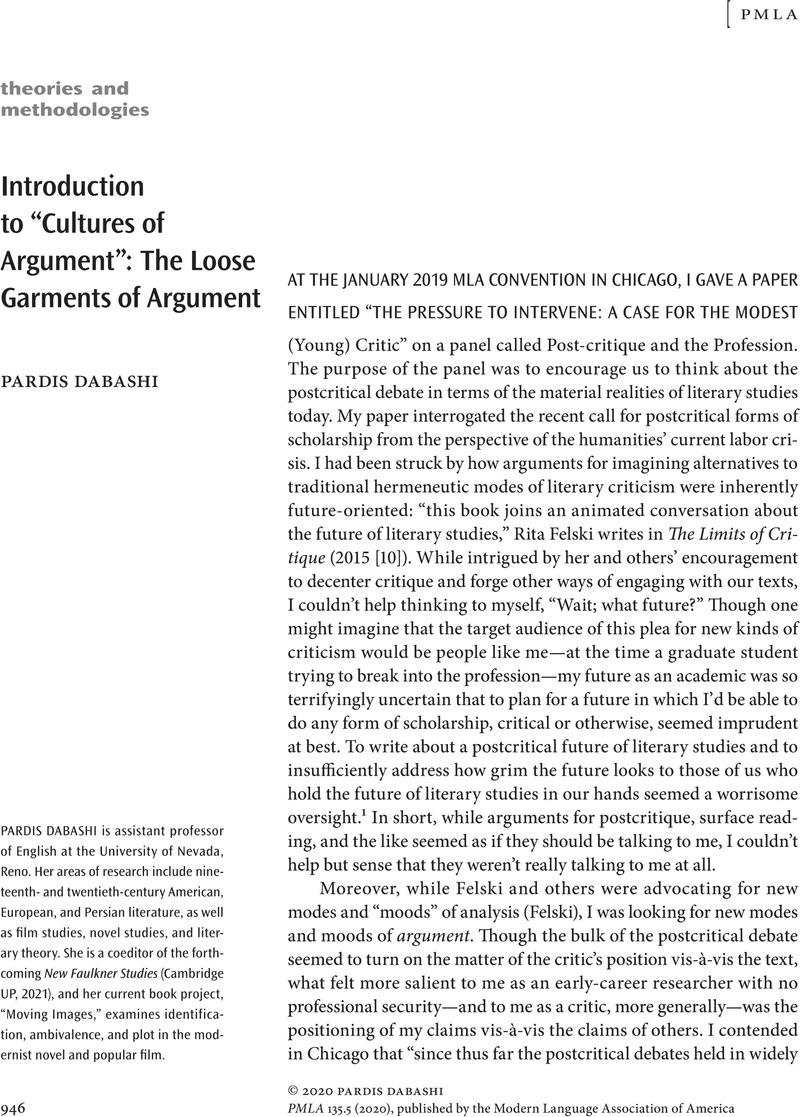No CrossRef data available.
Article contents
Introduction to “Cultures of Argument”: The Loose Garments of Argument
Published online by Cambridge University Press: 18 January 2021
Abstract
An abstract is not available for this content so a preview has been provided. Please use the Get access link above for information on how to access this content.

- Type
- Theories and Methodologies
- Information
- Copyright
- Copyright © 2020 Pardis Dabashi
References
Works Cited
Anderson, Amanda. The Way We Argue Now: A Study in the Cultures of Theory. Princeton UP, 2006.Google Scholar
Best, Stephen, and Marcus, Sharon. “Surface Reading: An Introduction.” The Way We Read Now, special issue of Representations, edited by Best and Marcus, vol. 108, no. 1, Fall 2009, pp. 1–21.CrossRefGoogle Scholar
Chander, Manu. “Contention and Contestation: Aesthetic Culture in Kant and Bourdieu.” Philosophy and Culture, special issue of Romantic Circles Praxis Series, edited by Rei Terada, June 2008, romantic-circles.org/praxis/philcult/chander/chander.html.Google Scholar
Chihaya, Sarah, et al. Introduction. The Ferrante Letters: An Experiment in Collective Criticism, Columbia UP, 2020, pp. 1–13.Google Scholar
Clune, Michael W. “Judgment and Equality.” Critical Inquiry. vol. 45, no. 4, Summer 2019, pp. 910–34.CrossRefGoogle Scholar
Dabashi, Pardis. “Dear Nella: What Did You See?” Modernism/Modernity, 13 Nov. 2019, modernismmodernity.org/forums/posts/dabashi-dear-nella.Google Scholar
Dabashi, Pardis. “The Pressure to Intervene: A Case for the Modest (Young) Critic.” Post-critique and the Profession. MLA Annual Convention, 4 Jan. 2019, Hyatt Regency, Chicago.Google Scholar
Elkins, James. “An Introduction to the Visual as Argument.” Theorizing Visual Studies: Writing through the Discipline, edited by Elkins, et al., Routledge, 2012, pp. 25–60.CrossRefGoogle Scholar
Field, Allyson Nadia. Uplift Cinema: The Emergence of African American Film and the Possibility of Black Modernity. Duke UP, 2015.CrossRefGoogle Scholar
Fitzpatrick, Kathleen. Generous Thinking: A Radical Approach to Saving the University. Johns Hopkins UP, 2019.Google Scholar
Graff, Gerald, and Birkenstein, Cathy. They Say / I Say: The Moves That Matter in Academic Writing. W. W. Norton, 2018.Google Scholar
Hartman, Saidiya. Wayward Lives, Beautiful Experiments: Intimate Histories of Riotous Girls, Troublesome Women, and Queer Radicals. W. W. Norton, 2020.Google Scholar
Jameson, Fredric. The Political Unconscious: Narrative as a Socially Symbolic Act. Cornell UP, 1981.Google Scholar
@jaxwendy (Jacquelyn Ardam). “I've been watching the conversations around @MModernity's ‘Weak Theory’ issue unfold from the sidelines and here is my take: sure is easy to claim weakness when you have tenure or TT job. The Q of weakness looks v different from the land of the contingent.” Twitter, 21 May 2019, twitter.com/jaxwendy/status/1130937926156738562.Google Scholar
Landy, Josh. “Deceit, Desire, and the Literature Professor: Why Girardians Exist.” Republics of Letters: A Journal for the Study of Knowledge, Politics, and the Arts. vol. 3, no. 1, 15 Sept. 2012, pp. 1–21.Google Scholar
Landy, Josh. “The Most Overrated Article of All Time?” Philosophy and Literature. vol. 41, no. 2, Oct. 2017, pp. 465–70.CrossRefGoogle Scholar
Love, Heather. “Close but Not Deep: Literary Ethics and the Descriptive Turn.” New Literary History. vol. 41, no. 2, Spring 2010, pp. 371–91.Google Scholar
Mendelman, Lisa. “Strong Character, Weak Theory.” Responses to the Special Issue on Weak Theory, Part IV. Modernism/Modernity, 16 May 2019, modernismmodernity.org/ forums/posts/responses-special-issue-weak-theory-part-iv.Google Scholar
Morrison, Toni. Playing in the Dark: Whiteness and the Literary Imagination. Harvard UP, 1992.Google Scholar
North, Joseph. Literary Criticism: A Concise Political History. Harvard UP, 2017.CrossRefGoogle Scholar
Ruddick, Lisa. “Professional Harassment.” Critical Inquiry. vol. 26, no. 3, Spring 2000, pp. 601–09.CrossRefGoogle Scholar
Ruddick, Lisa. “The Unnamed Work of English.” ADE Bulletin, no. 151, 2011, pp. 29–35, doi:10.1632.ade.151.29.CrossRefGoogle Scholar
Sedgwick, Eve Kosofsky. “Paranoid Reading and Reparative Reading; or, You're So Paranoid, You Probably Think This Introduction Is about You.” Novel Gazing: Queer Readings in Fiction, edited by Sedgwick, , Duke UP, 1997, pp. 1–37.CrossRefGoogle Scholar
Seita, Sophie. Provisional Avant-Gardes: Little Magazine Communities from Dada to Digital. Stanford UP, 2019.Google Scholar
Vadde, Aarthi, and Micir, Melanie. “Obliterature: Toward an Amateur Criticism.” Modernism/Modernity. vol. 25, no. 3, Sept. 2018, pp. 517–49.Google Scholar
Vadde, Aarthi. “Weak Theory in the Mainly Precarious Room.” Responses to the Responses on the Special Issue on Weak Theory. Modernism/Modernity, 15 Aug. 2019, modernismmodernity.org/forums/posts/responses-responses-special-issue-weak-theory.Google Scholar


